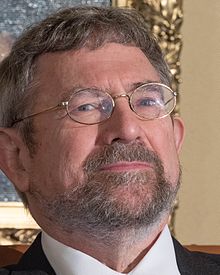J. Michael Kosterlitz
Michael Kosterlitz | |
|---|---|
 Kosterlitz at Nobel press conference in Stockholm, Sweden, December 2016 | |
| Born | John Michael Kosterlitz June 22, 1943[3] Aberdeen, Scotland, United Kingdom |
| Nationality | British |
| Citizenship | United States |
| Alma mater |
|
| Known for | Berezinskii–Kosterlitz–Thouless transition KTHNY theory |
| Awards |
|
| Scientific career | |
| Fields | David Thouless (postdoc) |
| Website | vivo |
John Michael Kosterlitz (born June 22, 1943) is a Scottish-American physicist. He is a professor of physics at
Education and early life
He was born in
Career and research
After a few
Kosterlitz does research in
]Awards and honours
Michael Kosterlitz was awarded the
The Kosterlitz Centre at the University of Aberdeen is named in honour of his father, Hans Kosterlitz, a pioneering biochemist specializing in endorphins, who joined the faculty after fleeing Nazi persecution of Jews in 1934.[11]
Personal life
Kosterlitz was a pioneer in Alpine climbing in the 1960s, known for working routes in the UK, Italian Alps, and Yosemite.[12] There is 6a+ graded route bearing his name in the Orco Valley of the Italian Alps named Fessura Kosterlitz.[13] Kosterlitz is an American citizen and is an atheist.[14] He was diagnosed with multiple sclerosis in 1978.[15]
See also
References
- ^ PMID 27708331.
- ^ "Lars Onsager recipient 2000, John Michael Kosterlitz Brown University". aps.org. American Physical Society.
- ^ "J. Michael Kosterlitz - Facts". Nobel Foundation. Retrieved 2016-11-02.
- ^ "Kosterlitz Research profile at Brown University". brown.edu. Brown University.
- ^ a b c d e f "Two former Birmingham scientists awarded Nobel Prize for Physics". University of Birmingham. 4 October 2016. Retrieved 4 October 2016.
- ^ Anatomy of a Scientific Discovery: The Race to Find the Body's Own Morphine, by Jeff Goldberg, Skyhorse Publishing, Inc., 13 Dec 2013, Brain Soup
- ^ Davidson, Peter (12 December 2016). "Aberdeen-born Academic Picks Up Nobel Prize for Physics". Evening Express. Retrieved 15 December 2016.
- EThOS 711269.[permanent dead link]
- ^ Devlin, Hannah; Sample, Ian (2016-10-04). "British trio win Nobel prize in physics 2016 for work on exotic states of matter – live". the Guardian. Retrieved 2016-10-04.
- ^ "APS Fellow Archive". www.aps.org. Retrieved 2022-08-11.
- ^ "Launch of Kosterlitz Centre in Aberdeen 2010". abn.ac.uk. University of Aberdeen.
- ^ "Mike Kosterlitz 2016 Nobel Prize Winner". alpine-club.org.uk. Alpine Club. 15 October 2016.
- ^ "British Climber Michael Kosterlitz awarded Nobel Prize in Physics". ukclimbing.com. UK Climbing 10/2016. 5 October 2016.
- ^ “J. Michael Kosterlitz - Biographical.” Nobelprize.org, . "I was a nominal church going Christian until I left home for Cambridge University on a scholarship when, to my great relief, I could drop all religion and become my natural atheist self...My wife and I finally became citizens of the USA in 2004."
- ^ “J. Michael Kosterlitz - Biographical.” Nobelprize.org, . "It turned out I did indeed suffer from MS."
External links
 Media related to Michael Kosterlitz at Wikimedia Commons
Media related to Michael Kosterlitz at Wikimedia Commons- J. Michael Kosterlitz on Nobelprize.org
